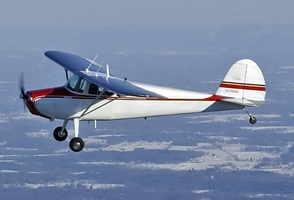Even my cruise prop (7655) will get off the ground with about the same as book ground runs....but that climb to clear the 25' pwr line at the end of my strip can keep my attention on a warm summer day with full fuel and pax and baggage. It takes the full 3500' I've got sometimes.
(Remember - - Don't retract flaps until the obstacles are cleared! The book performance is done with the flaps at the takeoff position specified until obstacles are cleared. Flap retraction prior to the obstacle will increase distance required.)
Meanwhile.... back to the engine: The C145/O300 makes rated power (145 hp) only at 2700 rpm. No one gets that rpm though. (See the Type Certificate Data Sheet (TCDS) which specifies a standard prop will only make 2230-2330 static....This means you only get 120 hp at takeoff with a standard prop.)
If you can use a prop with a finer/flatter pitch you will get higher rpm and therefore more horsepower. That's why a "climb" prop will takeoff/climb in a shorter distance.
The "175 hp O-300" engine you've been told about is probably the GO-300 engine that was used in the C-175 airplane. It was not a success for several reasons. It only made 175 hp by using a gear-box which was built into the front of the engine between the crankshaft and the propeller. This allowed the engine to turn more rpms and therefore make more hp. It was like running the engine in second-gear all the time. This made the engine burn more fuel and wear out faster. (It only had a 1200 hour TBO and virtually none of them made it anywhere near that without major cylinder repairs.) The engine is now considered un-supportable. Many parts are no longer readily available, especially thrust bearings.
Even so, you wouldn't want to convert to that engine. It'd be much simpler to convert to an already existing, certified (STC'd) engine/prop like the Lycoming O-360 or TCM IO-360. (About $35K-$45K)
